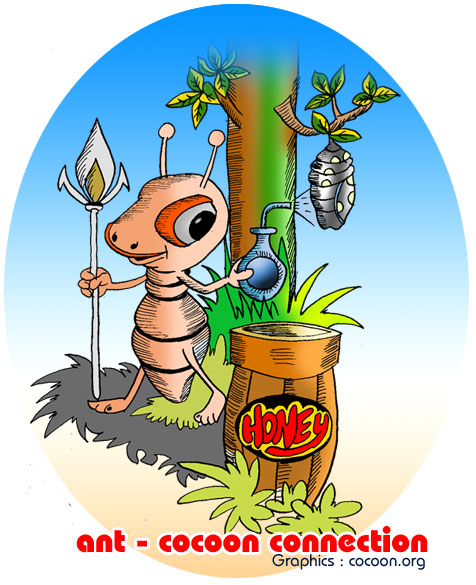Ant – Cocoon Connection

In the life history of butterflies and moths the pupal stage is vulnerable to predators. Strategic location, thick casing, camouflage, repulsive odors and sound production are some of the means by which the pupa or cocoon protects itself.
Some pupas are special. They belong to the Lycaenid butterflies, the Blues, Coppers, Hairstreaks and Azures. They have a strange association with Ants, which take care of them right from the larval stage up to the completion of the pupal stage.
Each butterfly species is associated with a particular species of Ant. The association is described as Myrmecophilous association. The ants are called “attendant ants”. The ants guard the larva and pupa by driving away parasitic wasps and predatory flies, by spraying formic acid and displaying their strong claws. In return, the ants are rewarded with food in the form of a thick sugary liquid from the larva or the pupa. This is in other words, a give and take relationship between the two. It is called Mutualism.
Larva of the Common Imperial Butterfly pupates inside the ant nest. The ants take care of the larva and continue to guard the pupa. In about 3 to 4 weeks, the adult butterfly emerges from the pupa. It crawls out of the ant nest, enlarges its wings and flies away.
The pupa has honey glands in the middle of its abdominal segment, seven.. The honey glands secrete a thick sugary liquid rich with amino acids. The ants feed on this nutritious ‘honey’, and are obliged to protect their food source.
Larva of Maculinia butterflies produces special chemicals (hydrocarbon compounds).The chemicals are similar to those of ant larvae, and induce ant workers to carry the larva into their nests. The butterfly larva is not only safe inside the ant nest, but also has a rich supply of food, the ant eggs and ant larvae. Having safely lodged, the butterfly larva now produces exclusive chemicals which the ant colony can recognize easily and give extra care and pay special attention.
The Pupa has additional equipment, the file and scraper organs on its abdominal segments five and six. These organs (stimulatory organs) produce vibration sounds to which ants respond in large numbers. Added to this, the pupa also produces chemicals from a pair of glands on its third thoracic segment. These chemicals are similar to those produced by the ‘Queens’ and ‘sisters’ of the ant colony. The worker ants rush to the pupa and drive away the intruders. The ants do not get the ‘honey’ in this case.
With such a population of attendant ants, the pupa has the protection, guaranteed. It is like having security guards with least expense!
Bee Cocoons
What is a Cocoon
Cocoons in the winter time
How long Cocoon Last?
Silk Made From Cocoon
Silkworm Cocoon
Orgin of word Cocoon
The Surprises in Cocoons
Types of Insects in Cocoon
Butterfly or Moth Cocoon
Making of Cocoons
Ant – Cocoon Connection
From Cocoon to Adult: Role of Hormones
Cocoon that resembles a Bag
Cocoon Architecture
Mud Cocoons
Interesting Cocoons
Cocoon Food
Glochidium Cocoon
Sleeping Bag Cocoon
Cremaster, Nature’s Velcro
Frog Cocoon
Earthworm Cocoonv
Cocoon Rattles
Mites And Bee cocoon
Say No to Silk
Cocoon Inside Cocoon
Sensing From Inside Cocoon
Cocoon That Resembles Rabbit droppings
Hammock Shaped Cocoon
Chipwood Cocoon
Slime Cocoon
Cocoon For Eggs
